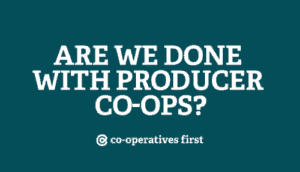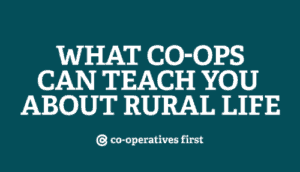Unique co-ops are more common than you think
The co-operative business model is versatile and being used successfully in every sector of the economy, leading to some pretty unique co-ops. Businesses using the model bring utilities, like power, water and broadband to rural and Indigenous communities, offer a variety of services, such as daycare, global marketing and food processing, and, of course, sell stuff to consumers through retail stores.
As awesome as the business model is, the co-operative business model is simply a tool for governing how people organize and work together to achieve a goal. It’s the people at the heart of the project who are truly amazing, and the resulting business is often an expression of the character and individuality of the group of people who have organized to make it happen.
Here’s 6 organizations (thanks to the hard work of 6 unique groups of people) that happened to organize as unique co-ops:
Steep Hill
Steep Hill is a bulk food retail store located in the Broadway area of Saskatoon, SK. Started in 1978, this unique non-profit consumer co-operative has been operating for forty years – an impressive feat for any organization.
The goal of the business is to supply its membership with high quality local food at fair prices. The co-op model helps the business maintain control over this purpose, and the member-driven mandate encourages management to source local, generally organic and natural (minimal processing), foods.
Local and organic food often comes at a premium price. To reduce prices, Steep Hill prioritizes getting high quality local and organic food into its member’s homes over creating a profit. At this unique co-op, local producers get fair prices, local consumers get fair prices, Broadway has a stable local business for years and a couple local people get jobs. Now that’s how to do local. In fact, this store is so authentic it even smells local, organic and natural. (But in a welcoming and good way, of course.)
To further help reduce prices for members, Steep Hill has implemented a unique pricing structure. Members of the public pay a mark-up of 25%. Members of the co-op pay a mark up of 10%. Members of the co-op that contribute a couple hours of volunteer work stocking shelves and cleaning pay the shelf price (which is a pretty sweet deal).
Terminal City Glass
Established in 2012, Terminal City Glass Co-op (TCGC) is Canada’s “first and only” co-operative glass arts facility.
The goal of the co-operative is to provide access to high quality equipment, space, training and resources to emerging and established glass artists in Vancouver, BC. The co-operative model provides artists the opportunity to pool resources and gain access to a facility, equipment and resources that would be challenging and largely inefficient to manage on their own. In many ways, the space is a kind of incubator for local glasswork businesses.
In addition to providing capacity for artists and their businesses, the co-op also serves as an education, market development and public relations mechanism for glass artists and the promotion of glass work as an art form. This co-op takes glass work as an art form very seriously and is working to help the rest of the world understand its value too.
Come As You Are
We’ve explored this unique co-op at some length before. But we love it and the business has shown surprising agility in the face of significant change during its 20 years in operation. Plus, it’s without question 100% unique.
Today, Canada’s (and perhaps the world’s) only sex shop co-op, aptly named Come As You Are, is an online store. But for the first two decades of operations this worker co-operative ran a physical shop and educational programming. It has also regularly been voted Toronto’s best sex shop since 1997 – the year it opened.
The goal of the business is to provide a “sex-positive,” safe, comfortable approach to sexuality and its expression. The co-op is actively involved in sex education and outreach – particularly within universities.
The co-op has survived a revolving door of worker-owners by providing a governance structure that opens opportunities for succession for the business. Much of their success can probably be attributed to maintaining values that attract worker-owners willing to carry the co-op’s vision and mission forward.
London Brewing
As the first brewery in Canada based on a worker co-operative model outside of Quebec, London Brewing Co-operative is exactly what you’d expect from a dedicated group of beer making artisans: a serious concern for the art of beer making.
Two top priorities of the business are to produce great beer and meaningful employment. Two very worthy goals, especially when you connect this to a desire to create a community gathering space where you can play world-class Euchre. (If that doesn’t make you a bit different, I don’t know what does.)
The worker co-operative model offers the business democratic decision-making and employee ownership. Employee ownership and providing everyone a voice in the business increases employee interest in the well-being and success of the venture. (It probably doesn’t hurt the quality of the beer either.)
Mountain Equipment
Started in 1971 by “a few young climbers in the mountains who dreamed of gear that wouldn’t let them down at prices they could afford,” Mountain Equipment Co-op (MEC) is probably the largest consumer co-op in Canada by membership (about 5 million members).
The goal of the co-operative is to inspire outdoor living and provide members competitive pricing for outdoor living gear. At MEC, they live and breathe what they sell. Every member of the executive team and board is an avid outdoorsy person and active living advocate. And they only sell to their members – so this is a large but exclusive club.
As a business, MEC offers gear, advice and community. Three things the co-operative model serves up well.
Stocksy United
This unique multi-stakeholder platform co-operative is a favorite of ours. We had the great pleasure of hosting Stocksy United’s CEO, Brianna Wettlaufer at a “women in tech” conference that we put on in Saskatoon last year. Brianna is awesome and so is Stocksy.
Like many of the other co-ops on this list, Stocksy’s founders were concerned about providing a quality product and meaningful employment. The stock photo industry is pretty cut throat and making a living as a photographer is tough. By paying their member contributors better, Stocksy has been able to offer higher value revenues for their 900+ contributing members and curate the content to elevate the entire stock photography industry. Today, they set the standard for quality stock photography.
So, there you have it. 6 unique co-ops and the inspired people who started them. Now get out there and join a unique co-op near you. And if you want to start one, find some friends to join you and contact us. We can help you get started.






